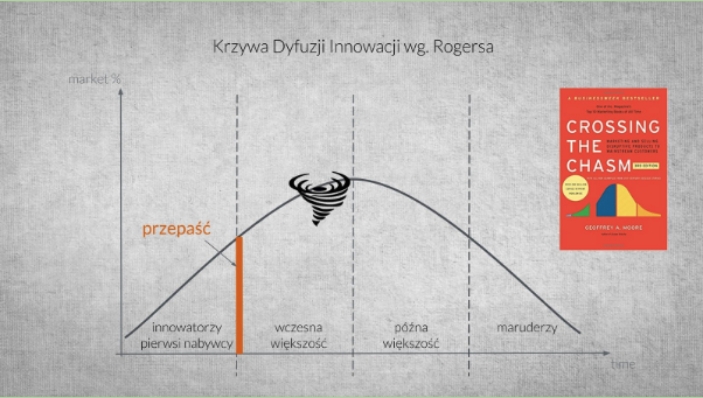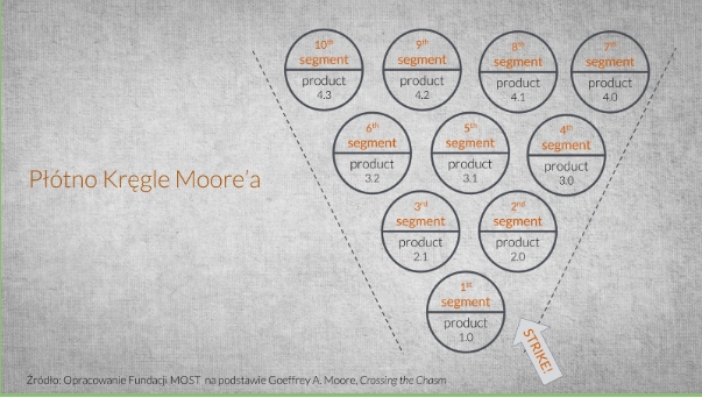
In this article, I would like to share with you the methodology that we successfully use at the MOST Foundation to determine the priority paths for commercialising our clients’ new products and services. I am talking about Moore’s Bowling pins. If you are developing your own technological product or wondering how to go about introducing a new technology or innovative service to the market, I invite you to read on.
One of the fundamental challenges facing every growing technology company is choosing the customer group
on which to focus its attention and resources. An effective go-to-market strategy requires, above all, the entire team to focus its attention on a leading, promising market segment. A lack of priorities and a dispersion of attention and resources hinders the healthy growth of the company. At the MOST Foundation, we help entrepreneurs define their go-to-market strategy for a new technological solution.
In his book Crossing the Chasm, Geoffrey A. Moore develops the classic model of innovation diffusion (according to Rogers), focusing on the turning point between the early adopters phase and the early majority phase.

As you know, new solutions usually gain the interest of buyers gradually. First, a new product or service is purchased by innovators, enthusiasts of novelties and early adopters, who are visionaries open to new, non-standard solutions. Next, the solution is purchased by pragmatic buyers from the early majority group, then conservative customers from the late majority group, and finally the so-called laggards, who are sceptical about new solutions. It should be noted that the increase in popularity of the solution creates high demand, which enables suppliers to achieve economies of scale and generate large, stable revenues and profits. However, this only happens in the middle and late majority stages. Therefore, it is important to have a large, preferably dominant, market share in the third stage.
As a result, the battle for market dominance is fierce and lasts practically throughout the entire second phase.
Moore focuses on this, making three very important observations:
01. Convincing the first enthusiastic buyers is much easier than selling a new solution to pragmatic customers from the early majority group, which is why there is a gap between these stages that should be the main challenge for every start-up.
02. The battle for market dominance takes place in the second phase: the early majority, which is why
our future market position, our ability to survive
and generate profits depends on how we cross the chasm.
03. Third, and for me perhaps the most important observation: if you want to dominate the market, first dominate the segment! Therefore, you should carefully consider which market segments (i.e. customer groups) to target with your solution and in what order.
This is where Moore’s bowling pins come in. Using the analogy of bowling pins on a bowling alley, Moore recommends defining segments precisely and then arranging them in a so-called ‘cone’. At the top of the cone should be the segment with the highest priority. As you know from bowling, if you hit the first pin with the right force and precision, you have a better chance of getting a strike, i.e. knocking down all the pins.

Why is it so important to determine the correct order of attack for each segment? As I wrote earlier, it is important to remember that buyers in the early majority group are pragmatic. They need to get a 100% solution to their problem. The solution we offer must respond very well to their expectations (all relevant functionalities, appropriate UX/ergonomics, reliability, proper service at the sales stage, service and after-sales support). Moore refers to such a solution as a Complete Product. Early adopters will be satisfied with an MVP (Minimal Viable Product) and are willing to pay for a product that is 80% complete, while the early majority is much more sceptical.
A Complete Product must have all the necessary features that the early majority requires. Unfortunately, this often necessitates significant investment in product development to adapt it to the needs reported by a given segment. Therefore, especially with limited resources, precise segmentation makes it easier for us to deliver the Complete Product to individual segments more quickly. As a further consequence, precise segmentation helps us to conquer the market more efficiently, segment by segment. The result is the generation of stable revenues from the segments we have conquered and the maintenance of financial liquidity, which is a concern for almost every start-up business.
If you want to dominate the market, first dominate the segment. If you plan your market entry strategy to conquer it segment by segment, pin by pin, it will be easier for you to effectively use the limited resources at your disposal.
By following this rule, you can focus on the product features that are most important to your customers. This will allow you to start selling effectively faster and generate steady, recurring revenue. As a result, you will be in a stronger position to conquer the next segment. I encourage you to draw your own circles today so that tomorrow you can focus 100% on customers from the segment that is most important to you.
You will probably quickly discover that defining segments correctly is not easy and requires practice. I would love to hear about your experiences – be sure to share them in the comments!